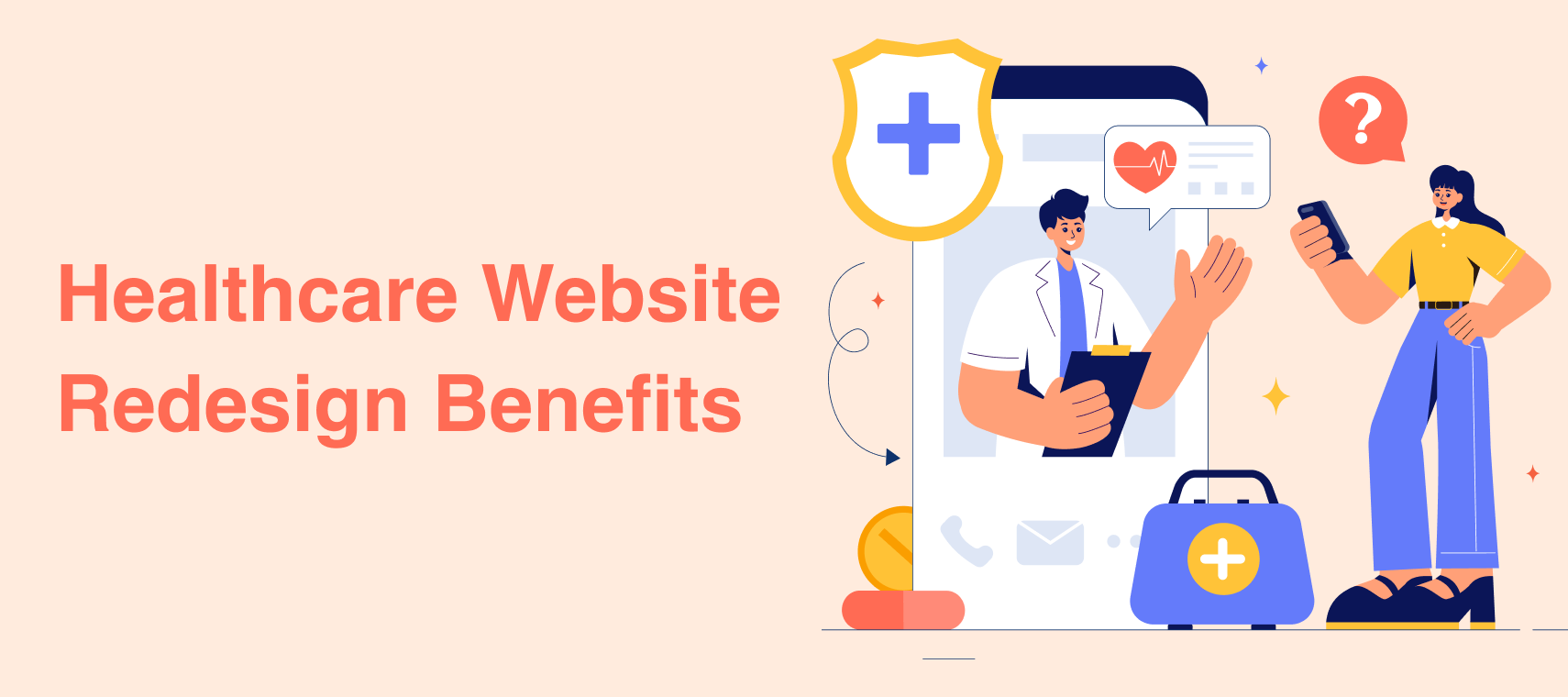Table of Contents
- Why Now Is the Time to Rethink Your Healthcare Website
- Healthcare Website Redesign Benefits
- Conclusion
- Frequently Asked Questions
Healthcare organizations must prioritize their website design because patients use it as their initial contact point with medical services. A website that presents itself as modern and easy to navigate while showing trustworthiness will drive patients to select your practice instead of seeking care elsewhere.
A healthcare website redesign requires more than visual changes because it involves creating an experience that patients can use to find services and make appointments through a secure platform. The digital experience for patients requires speed and accessibility, and security features to create a patient-centered environment. The website design should present information about services and appointment scheduling, and patient resources through a simple interface that enables patients to access everything they need without difficulty.
A website redesign that incorporates new elements helps organizations develop better credibility with their audience. Your website’s professional design, combined with compassionate elements and standard compliance through HIPAA and ADA, will establish trust between your organization and all its stakeholders. Your organization will attract more qualified patients through search engine results when you implement SEO best practices during your website redesign.
A well-planned website redesign for healthcare organizations leads to better patient interactions and higher satisfaction rates, and sustained business expansion. A website redesign represents more than visual changes because it establishes an authentic digital platform that demonstrates your organization’s daily commitment to delivering high-quality medical care.
Why Now Is the Time to Rethink Your Healthcare Website
Healthcare organizations have experienced rapid transformation during the previous few years, while patients have developed new requirements for their care. Your website from 2015 does not fulfill the digital requirements that patients expect from healthcare providers in 2025. Patients now expect healthcare organizations to provide digital services that match the smooth user experiences found in contemporary consumer brands.
Leading healthcare organizations, including hospitals and clinics, and telehealth providers, now dedicate resources to developing sophisticated digital platforms. The websites these organizations build serve as secure platforms that provide mobile access and maintain compliance standards while showcasing both technological progress and patient-centered care. Your organization must implement modern digital solutions to maintain market competitiveness because it will generate both increased website traffic and enduring patient trust.
A contemporary website enables your organization to enhance its presence on the internet. Google now favors healthcare websites that deliver fast performance and mobile accessibility and maintain HTTPS security, and present valuable content that addresses patient needs. A website update demonstrates to patients that their health information and personal data receive complete protection.
Your organization needs to perform a website redesign to remain competitive in the market.
Healthcare Website Redesign Benefits You Should Know
Your healthcare website serves as the main entry point for patients to access your practice in today’s digital environment. The first encounter between patients and your healthcare organization occurs through your website, which presents your brand values and medical standards.
Outdated websites with complicated navigation and insufficient expert representation will push potential patients to seek care elsewhere. A contemporary website redesign that focuses on patient needs will create an excellent first impression while enhancing both website visibility and patient trust and engagement.
The following article explains how a healthcare website redesign in 2025 will deliver maximum benefits to your online presence while explaining the immediate need for this transformation.
Improved User Experience (UX)
Any healthcare website needs a user experience to achieve success. Your website attracts patients who want to find clear answers and feel confident while experiencing easy access to information. The website redesign process enables you to create a structure that fulfills patient requirements by placing essential information, such as services and doctor details, location maps, and contact information, in accessible locations.
Users can concentrate on their health needs because your website features a simple design with easy-to-use navigation and clear text, and limited distractions. The organization of content through patient journey stages such as “New Patients,” “Emergency Care,” and “Telehealth Appointments” leads to lower bounce rates and extended user engagement.
A user-friendly interface creates better patient satisfaction while establishing trust and loyalty, which form the foundation for healthcare organization success.
Enhanced Mobile Responsiveness
Patients from today’s world access information through mobile devices first. Your website needs to deliver perfect performance for all users who access it through mobile devices while they search for clinics or schedule appointments, or read health content.
A responsive design system changes your website layout and elements based on screen dimensions to create an optimal user experience.
Google reports that healthcare searches now exceed 60% through mobile devices. A website that does not adapt to mobile devices will drive away most of your visitors while making your search engine rankings suffer.
A website redesign creates a healthcare website that provides patients with an excellent mobile-friendly experience to access your services at any time through any device.
Faster Website Loading Speed
Healthcare operations require fast speeds because they need immediate results. A website that takes too long to load will immediately cause patients to become dissatisfied when they need urgent information or same-day appointments.
The website redesign implements backend optimization through simplified code and optimized media files, and enhanced caching systems. The website achieves page loading times that meet the three-second industry benchmark.
A website that loads quickly will achieve better Google search positions while creating positive user experiences and decreasing the number of users who leave the site. A website that loads quickly demonstrates to patients that your organization respects their time while delivering efficient services.
Stronger Brand Credibility
Healthcare organizations require absolute credibility to succeed. A website that lacks updates creates an impression that your medical practice has not adopted contemporary healthcare standards.
A website redesign enables you to present your brand through contemporary design elements and unified color patterns and narratives that focus on patient needs. The combination of custom images with genuine staff portraits and professional font styles creates an atmosphere that feels both trustworthy and dependable.
Your website will mirror the professional standards and patient-focused care, and empathetic approach of your organization when its digital appearance matches your actual operational excellence.
Better SEO Performance
A website with great visual appeal becomes useful only when users can locate it. A website redesign enables you to Google crawlers through the implementation of keyword optimization and structured data, optimized meta tags, and a fast page build, improving search engine optimization (SEO) fundamentals throughout the entire process.
Your healthcare website becomes more accessible loading times.
The redesign process enables you to replace outdated content with fresh, medically accurate resources that fulfill Google’s EEAT (Experience, Expertise, Authoritativeness, Trustworthiness) standards.
Your services will appear in search results for patients who search “family doctor near me,” “urgent care clinic,” and “best telehealth provider” through organic traffic attraction.
Increased Patient Engagement
Modern patients require more than basic information because they need active participation in their healthcare experience.
A healthcare website redesign should include engagement tools that will enhance patient interaction.
- Live chat or chatbots for instant support
- Patient portals for secure record access
- Online forms for appointment requests
- Wellness blogs and video guides for education
The healthcare website elements create a supportive experience that accompanies patients throughout their entire medical process. The outcome leads to better patient satisfaction and longer on-site visits, and stronger patient retention rates.
Higher Conversion Rates
Your website functions as both an information center and a conversion system.
The website redesign process enables active patient acquisition through optimized conversion points, which include appointment forms and call-to-action buttons, and lead magnets.
The website features strategically positioned CTAs that lead users through a natural process to complete their next action, starting with “Book an Appointment“, “Meet Our Specialists”, and “Start a Telehealth Session”.
The improved website layout, combined with simplified booking procedures and reduced user obstacles, will result in quantifiable growth of appointments and inquiries and enhanced patient engagement, which represents the core objective for healthcare organizations.
Compliance with HIPAA and ADA Standards
A healthcare website needs to safeguard patient data while providing full accessibility to all users.
The website redesign process enables developers to make sure the website fulfills HIPAA requirements through secure data encryption for all transmissions and form submissions, and patient interactions.
The website must follow ADA (Americans with Disabilities Act) standards to provide accessible functionality for users who have visual or auditory, or cognitive disabilities. The website needs to support screen readers and maintain a suitable color difference, and enable users to navigate through the site using their keyboard.
Your organization avoids legal issues while showing patients your dedication to providing accessible, ethical medical services through compliance.
Integration with Modern Healthcare Tools
Healthcare websites achieve their best results through digital tool integration, which enhances operational efficiency and patient convenience.
Through redesign, your site can seamlessly connect to:
- Electronic Health Records (EHR)
- Telemedicine and virtual consultation platforms
- Online payment systems
- Prescription refill tools
The integration process streamlines operations while minimizing administrative work to establish a unified digital platform for patient care management.
Improved Data Security
Healthcare organizations face increasing cyberattacks, which target patient data as their most vulnerable online asset.
The website redesign focuses on enhanced cybersecurity through SSL certificate implementation and encrypted network connections and scheduled vulnerability assessments, and firewall defense systems.
Your website upgrade protects confidential patient information while establishing trust with visitors through responsible data management practices. Security functions as the essential element that builds trust because transparency stands as its starting point.
Streamlined Appointment Booking
A website redesign enables patients to schedule appointments through a straightforward process.
Modern websites can offer:
- Real-time scheduling systems
- Automated email or SMS reminders
- Doctor availability filters
- Secure online payment or deposit options
Patients will maintain their appointment bookings when the booking process becomes easy to use. Your clinic becomes more efficient through this process while patients experience better convenience.
Enhanced Content Strategy
A redesign enables you to create a new content system that includes all pages, starting from the homepage down to health blogs.
Your website transforms into a dependable healthcare resource through the publication of authoritative content that serves patients and receives medical verification. Your website becomes more accessible to patients through doctor bios and service pages, and FAQs written in basic terms, which establish trust relationships.
Your brand authority in your field will increase through regular blogging about relevant topics, including wellness tips and preventive care, and mental health awareness, which also enhances your website’s SEO performance.
Better Analytics and Tracking
Modern websites focus on using data intelligence during their development process.
The new website design incorporates Google Analytics 4 and Hotjar, and HubSpot analytics tools, which enable you to track:
- User behavior patterns
- Traffic sources
- Conversion metrics
- Form completion rates
The collected data allows you to create evidence-driven choices that help you enhance your website for better patient experiences and marketing results.
Stronger Online Reputation
Your online reputation stands as the most vital factor in an industry that depends on trust between patients and healthcare providers.
Your website serves as a credibility showcase through the display of patient testimonials and video stories and certification badges, and partnership affiliations. Your website becomes more transparent when you embed Google Reviews and Healthgrades testimonials, which helps patients make better decisions about seeking your care.
Your organization demonstrates its commitment to delivering high-quality medical services through a modern website that presents a professional image to both online and offline patients.
Future-Ready Digital Presence
The healthcare industry experiences an unprecedented pace of transformation because AI chatbots and voice search, and predictive scheduling technologies have emerged.
A website redesign creates a future-proof digital presence that maintains scalability and flexibility, and adaptability to upcoming industry trends. Your organization will maintain operational readiness to implement new features and third-party system integrations through future updates without requiring additional website construction.
Your healthcare organization will maintain its position as a relevant and competitive technological leader through current redesign investments.
Conclusion
A healthcare website redesign serves as a strategic investment that builds patient trust and enhances accessibility while driving long-term organizational growth. Your healthcare organization’s website functions as the primary entry point for patients to experience your organization’s credibility and care quality, and professional standards before they visit your facility.
Your organization can create a digital experience that matches your in-person care quality through modern design principles and mobile optimization and fast page loading, and HIPAA and ADA compliance maintenance. Your website redesign will enhance user satisfaction while helping you maintain search engine rankings and attract more suitable patients, and build your online standing.
A healthcare website built for the future combines visual appeal with advanced functionality through patient portals and telemedicine tools and scheduling systems, and analytics platforms, which turn your online space into an effective patient engagement and care delivery system. Your organization will maintain its position as a relevant and secure healthcare provider through digital maturity, which fulfills the changing needs of contemporary patients.










